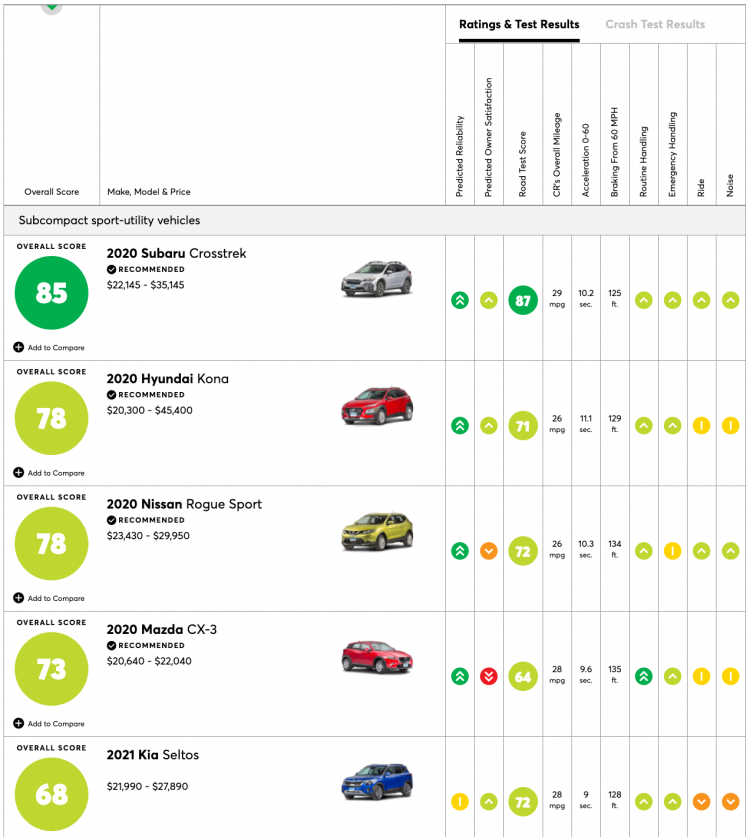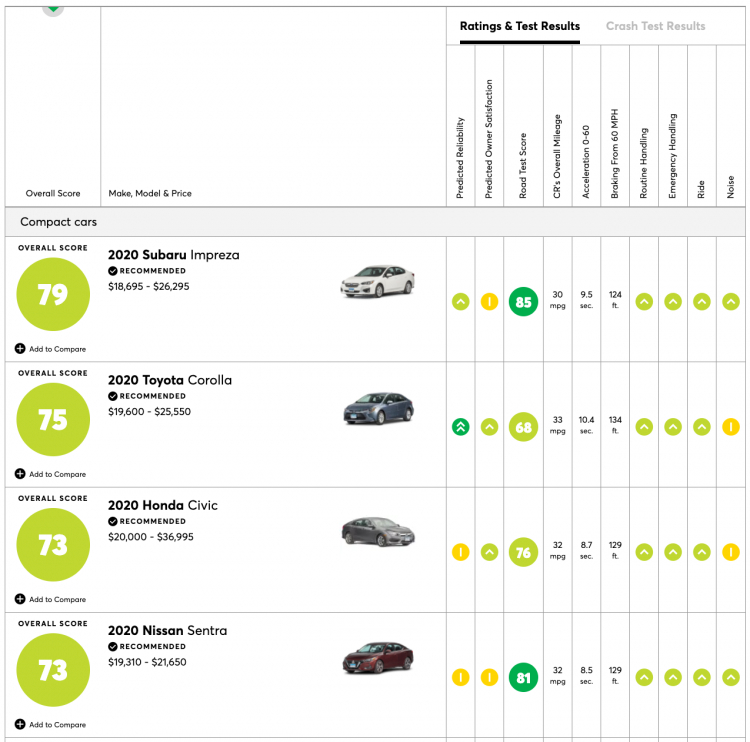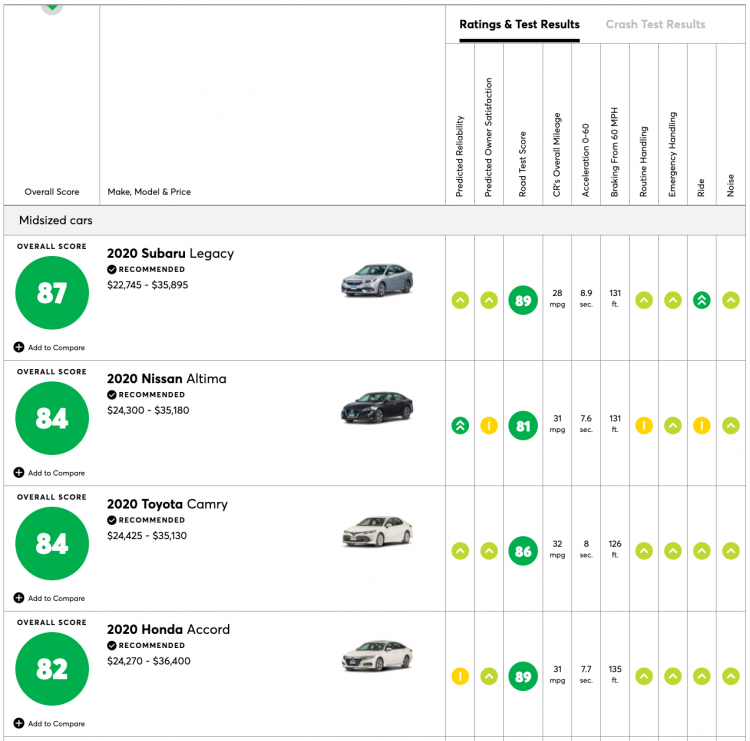The updated Subaru Forester is a smart, well-executed small SUV that boasts a roomy interior, great fuel economy, and plenty of standard safety equipment.hóng thêm report CR các xe khác. CX5 được xếp hạng 1 mà sao ở CNL bị chửi quá vậy chủ tịch. Chủ tịch copy & paste cái detail report Su giùm luôn nha.
Beneath the familiar exterior design, Subaru has made a lot of improvements without altering the SUV’s sensible, no-nonsense character. The ride is comfortable and supple, the steering is responsive, and there’s little body lean around corners.
The standard 2.5-liter four-cylinder engine is a little more powerful but that doesn’t make the Forester any quicker. Sprinting from 0-60 mph takes 9.2 sec—which puts it on the slow side compared to other small SUVs. In the real world, however, the Forester has enough power to pass and merge successfully. The continuously variable transmission (CVT) has been refined to be less obtrusive, but drivers still hear a pronounced engine buzz under acceleration.
Fuel economy is impressive at 28 mpg overall, tying the Honda CR-V EX for the best mileage of any small SUV that isn’t a diesel or a hybrid.
Ride and handling have also improved. The Forester is adept at absorbing road imperfections, making it one of the better riding SUVs in the category. And yet, it benefits from responsive handling with less body roll and quicker steering than the previous version when rounding corners.
The spacious interior has controls that are easy to use, plenty of headroom, and some of the best visibility of any new vehicle. The driving position helps provide a commanding view of the road ahead. Most versions come with a power seat that is comfortable and supportive, thanks in part to its adjustable lumbar support.
As is often true for Subaru, the controls are simple to reach and use. The latest infotainment system is intuitive and responds quickly. It is also compatible with Android Auto and Apple CarPlay.
On the utility front, the split seats fold nearly flat, leaving a slightly inclined surface for cargo. Opening the power liftgate exposes a wide, square-shaped space that can swallow a fair amount of bulky warehouse-store items. There’s even enough space with the rear seat folded down to fit a bicycle with both wheels on.
The Forester falters only when it comes to refinement. Despite upgraded soft-touch surfaces and additional padding, some interior materials look cheap. But what the SUV lacks in panache it makes up for in practicality.
Forward collision warning (FCW), automatic emergency braking (AEB), lane departure warning (LDW), and lane keeping assistance (LKA) come standard.
Best Version to Get
The Premium trim is a good place to start since it comes with a power driver’s seat, rear air vents, sunroof, and the All-Weather package (which brings heated front seats). We'd also get blind spot warning.
For additional convenience and luxury items such as leather upholstery, bigger infotainment screen, and dual-zone automatic climate control, the Limited trim is the way to go.
Notable changes:
The Forester was all new for 2019. We’re pleased to see that Subaru’s Eyesight suite of advanced safety features is now standard on all trims. Updates for 2020 include a standard rear-seat reminder system, and new functions added to the lane keeping assistance feature.
Driving Experience
1 / 3



The X-Mode alters how power is delivered to the wheels for better traction or light off-road.
Powertrain
The 2.5-liter four-cylinder engine has more horsepower than the previous model, but that doesn’t translate to quicker acceleration. Its 9.2-second 0-60 mph time trails some competitors. That said, the car feels responsive in everyday driving, responding promptly to the gas pedal.
The continuously variable transmission is largely unobtrusive and does its thing in the background. It’s only when drivers literally step on it, say, for a hill climb or a quick merge, that the transmission amplifies engine noise.
We measured an impressive 28 mpg overall, which ties with the Honda CR-V EX for best in class small SUV consumption that’s not a diesel or a hybrid.
Handling
The Forester is quite responsive in corners. Body lean is well contained and the steering effort is appropriate. The body remains well planted even on bumpy corners. But the Subaru does not possess the fun-to-drive nature of the Mazda CX-5, which is our go-to small SUV when buyers are looking for a more engaging driving experience.
On the track the Forester remained under control even when pushed beyond its cornering limits. It posted a commendable 53 mph through our avoidance maneuver course and instilled confidence.
This small SUV also proved capable on our road course, and felt balanced and forgiving.
Ride comfort
The Forester’s pliable suspension provides a supple and comfortable ride and yet minimizes ride motions, making the car feel steady. It absorbs bumps well and remains unfazed even on dirt roads. Uneven pavement can cause an occasional, quick side to side rocking motion, however.
Noise
The flat-four “boxer” engine has a characteristically coarse hum that’s not always the most pleasant sounding. At least good road and wind noise isolation make the car feel solid and substantial.
Braking
The Forester did superbly in our braking test, with very short stops on both dry and wet surfaces. The brake pedal provided plenty of feedback and was easy to modulate.
Partial automation
The Touring trim introduces DriverFocus, a system that monitors drivers’ head movement and warns them as a result of driver fatigue or distraction. If it detects that the driver’s eyes are closed or their head is not facing forward, the SUV chimes and displays a warning in the center of the instrument cluster. We found that it could detect some dramatic head movement, such as turning away from the road, but it could not discern some risky behavior such as gazing at a hand-held phone. Active cruise control is included in the EyeSight suite of safety features and it’s able to maintain speed and keep the car in lane. As such, it can be a stress reducer but it requires touching the gas pedal briefly by the driver when ready to resume driving after a stop in a traffic snarl.
Headlights
In addition to providing a very bright and uniform beam pattern, standard low and high beam LED headlights do a good job overall of lighting the road ahead.
Towing
The Forester can tow up to 1,500 pounds.
Off-road
A feature called X-Mode is standard. When activated, it optimizes the AWD system for better traction on loose gravel, sand and uneven rough terrain and it engages the hill descent feature, electronically limiting its speed on slippery downhills. But the car is not designed for hard core boulder climbing.
Inside The Cabin
1 / 2

It’s handy to have a dedicated space for the cargo cover.

The Forester’s infotainment system is easy to use.
Interior fit and finish
Cabin quality has taken a noticeable step up inside the new Forester, with improved plastics, more soft-touch surfaces, and nicer buttons and switches than several competitors. There’s a monotone black look, but the front door trims have padded window sills, soft cloth surfaces, a well-padded armrest, chrome-tipped window switches, and nicely-styled plastic trim.
The steering wheel is wrapped in leather with contrasting stitching, and the buttons have a damped feel. The trim surrounding the center stack feels pretty flimsy, though, and shows some odd panel gaps. The silver plastic trim around the gear selector is not that impressive.
Driving position
The Forester’s driving position proved roomy for a wide variety of people. The elevated seating position gives a commanding view of the road and the steering wheel provides plenty of tilt and telescope adjustment. We appreciate the well-positioned armrests, although the center one is a bit on the hard side. The left footrest is well placed. Drivers of almost all sizes will find that the center console intrudes on right knee space.
Visibility
It’s clear that Subaru wanted the new Forester to continue to have one of the best outward views of any vehicle. Roof pillars are all slim, and the windshield and side glass are large. Front views are further aided by extra triangle windows and low-placed side mirrors that are easy enough for the driver to see around. The rear window is large, too, but the views are blocked a bit by the rear headrests.
Blind spot warning and rear cross traffic warning are optional or standard on higher trims, but unavailable on the base model.
Seat comfort and access
As is the case of most vehicles in this class, the Forester is very easy to get into. The front doors open wide, leaving a large opening and easy to reach seat. The front seats are basic but still well liked by our testers. Our tested Premium trim has power adjustment on the driver’s side with a two-way adjustable lumbar. The passenger side has minimal manual adjustment.
The rear seat is also very easy to get into with a generous opening and easy to reach seat. The rear seat offers generous with room and facilitates a good posture.
Controls and displays
The Forester’s controls are easy to use and minimize distraction. Dedicated displays make viewing important information easy and uncluttered. The silver climate control knobs have nicely defined detents, and the smaller audio knobs work well, too.
Audio system
Dedicated buttons makes for a good user experience with the audio system. Changing sources and other frequent tasks take little effort, but the text in the screen is a bit small.
Navigation
A TomTom-based navigation system is available, which has simple graphics and thorough information. It performs well and displays weather information for the destination.
Phone
Drivers interact with paired phones for initiating or receiving calls mostly through the touch screen. Apple CarPlay and Android Auto are compatible as long as the device is plugged in.
Connectivity
Only higher trims with the eight-inch screen include voice recognition for entering an address in the navigation, music selections and climate choices. The voice command button on the steering wheel automatically switches to Siri or Google assistant when a device is plugged in.
The Forester supports Aha Radio and Pandora capability. If the Starlink app is installed on a smartphone, and it’s plugged in, owners get access to Yelp, iHeartRadio, Glympse, Eventseeker, and eBird (a bird watching app).
Climate features
Our tested Premium version came with a single-zone automatic climate control. The All-Weather package brings heated side mirrors and heated front seats. Everything worked well. The Limited has a dual-zone automatic system and the Touring adds heated rear seats. Owners can precondition the car through the Starlink app which enables remote start through a smartphone. But this service requires payment.
Cabin storage
Front passengers have an easy to reach open bin in the center console, making it a convenient spot to stash a phone. There’s also a covered storage bin with a small removable coin holder under the padded armrest between the seats.
Cup holders
Front passengers get two cup holders behind the gear selector. Both have a grippy rubber base, along with one flexible rubber anti-tip measure per holder. Rear seaters have two cup holders nestled into the fold-down center armrest. All four doors include built-in bottle holders.
Interior lights and visors
The sun visors do not slide on their mounting rods to increase side-glare coverage, but they do come with extenders to help block the sun.
Cargo area
It is easy to load items in back, thanks to the low liftover and wide opening. A power liftgate is available on all but the base model. The cargo space is generous and can accommodate bulky items, including a bike with the rear seatbacks folded down. The optional cargo rubber mat helps to corral dirt. The security blind can be conveniently stored under the cargo floor when not needed—a nice touch.
Spare tire
A temporary spare tire is standard across all trims.
Safety & Driver Assist Systems
1 / 1

The Eyesight suite of safety systems relies on two cameras that can be blocked by heavy rain.
Crash-test results
The Forester is an Insurance Institute for Highway Safety (IIHS) Top Safety Pick Plus.
Crash-avoidance systems
EyeSight, Subaru’s suite of safety features, is standard for all trim lines. EyeSight includes forward collision warning, automatic emergency braking, lane departure warning, lane keeping assistance, and adaptive cruise control. Note that this camera-based system (as opposed to radar) has limitations and may not work in heavy rain or bright sunlight. Blind spot warning, rear cross traffic warning and reverse automatic braking are available.
Forward collision warning, automatic emergency braking and pedestrian detection—This system is designed to reduce the likelihood and severity of a front crash, and can sense vehicles or pedestrians in your path. Multiple levels of alerts can be triggered depending on potential severity; the first is a visual and audible alert followed by different levels of automatic braking. During our track evaluations, with the car traveling at about 25 mph, the system successfully stopped the car avoiding striking the static dummy foam car.
Lane departure warning/lane keeping assistance—These systems operate above 40 mph. We find the systems most helpful while on long highway drives, since some can overreact on winding country roads. The lane departure warning may give so many audible warnings drivers might be tempted to turn it off. The system can be deactivated with a long press of a button by the rear view mirror. The lane keeping assistance system is designed to keep the vehicle within its lane with slight steering adjustments. However, it may also steer back toward a walker/cyclist when drivers attempt to veer toward the center to give them more space, which we find disconcerting. The on/off button for this system is on the steering wheel.
Blind spot warning—Like another set of eyes, this feature monitors the vehicle's flanks, indicating the presence of another car in a neighboring lane by illuminating a light on the side mirrors. It will flash a light if the turn signal is on and there is a car in the driver’s blind spot.
Rear cross traffic warning—When in reverse, the system scans for vehicles approaching from either side behind. This is a very handy feature for backing out of parking space or a blind driveway.
Reverse automatic braking—The system will give a visual and audible warning if there is an object in the rear bumper zone that the vehicle may collide with. The system will apply the brakes and stop the vehicle if a crash is imminent. It is up to the driver to step on the brake pedal to hold the vehicle.
Child safety
Overall, car seat installations with the seat belt and lower LATCH anchors are fairly easy in this rear seat. Some rear-facing child seats in the center seating position will be difficult to install with the seat belt. Lower LATCH anchors are available in every seating position, but LATCH use in the center seat comes at the cost of no LATCH use in the right outboard seat. Rear head restraints must be removed when using the top tether for all forward-facing installations and also when using a booster seat. Booster seat use in the center seating position will obscure use of the right outboard seat’s buckle and seating position. Three car seats will likely not fit across this rear seat.
Warranty
All cars come with basic warranty coverage, also known as a bumper-to-bumper warranty. This protects consumers against unexpected problems with non-wear items. Powertrain warranty protects against engine and transmission troubles. Rust through, or corrosion warranty, covers rust to non-damaged components. Roadside aid provides on-location assistance in case of a breakdown and may include limited towing services.
Extended warranties provide peace of mind. Owners of models known to have worse-than-average predicted reliability can mitigate risks with an extended warranty. Generally, we recommend buying a model with better-than-average reliability and skipping this expensive add on. If you do buy an extended warranty, it is key to read the small print to understand what is covered and where you can bring the car for repairs.
Basic
3 years/36,000 miles
Drivetrain
5 years/60,000 miles
Corrosion
5 years/unlimited miles
Roadside Aid
3 years/36,000 miles




